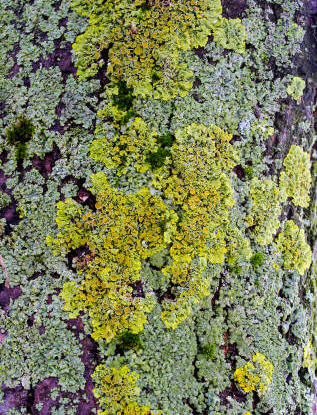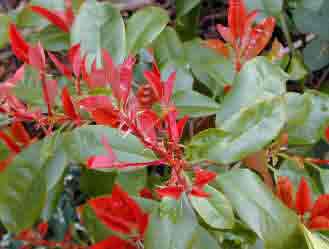Lichen in the Garden – Trees, Walls and Paving
(Lichen is pronounced in UK as ‘Lich-en’ in USA as 'Like-en’)
Lichen is a complex organism, sometimes referred to as a fungus; sometimes algae; sometimes moss. Two of those descriptions are nearly right for lichen is a combination of two separate and unrelated forms of ‘plant’ life - being part algae and part fungus. The two parts combine together to make up the organism that we refer to as lichen.
Whilst Lichen is a combination of two different organisms of fungi and algae, it is dissimilar in many respects to either if its component parts. Lichen is its own thing! It is a quite an interesting relationship, that only thrives as lichen if both component parts are present - a symbiotic relationship, where each of the two need the other to combine into lichen.
Lichens are not parasites. If they were, they would not live happily on inert materials such as stone walls and patio paving. There are many different types of Lichen, some of which seem happy on either stone surfaces or tree trunks. They do not need their ‘hosts’ for food and neither do they have root systems that search for food.
 Lichens
are self-contained units that obtain their nutrition need direct from
the atmosphere by way of assimilating energy-producing sunlight, carbon
dioxide, assorted mineral foodstuffs and water from their surrounding
environment. They do this by the process of Photosynthesis - as with
plants.. Lichen are basically self contained units that simply need the
environment which we take for granted.
Lichens
are self-contained units that obtain their nutrition need direct from
the atmosphere by way of assimilating energy-producing sunlight, carbon
dioxide, assorted mineral foodstuffs and water from their surrounding
environment. They do this by the process of Photosynthesis - as with
plants.. Lichen are basically self contained units that simply need the
environment which we take for granted.
Most algae and fungus species are happy living their own quite separate lives and rarely feel the need to cohabit with the other. Lichen is different. It is a combination of specific types of both fungi and algae.
Lichen on Trees – Tree Lichen
Lichen is seen in many areas of the garden, often being cause for needless concern - especially when it is seen on the trunks of trees. Lichen is totally harmless when found on trees. Tree Lichen simply uses the bark of trees as a nice place to set up home. It lives on the outer surface of tree bark which is dead and simply acts as a protective covering for the living inner-bark and the cambium layer - the main transportation area for the tree – between the living inner bark and the non-living woody trunk.
No part of the Lichen penetrates the bark, nor ‘feeds’ on the tree in any way.
Tree Lichen is a good indicator that your air is in good shape with very little in the way of man-made pollutants. Lichen does not live in polluted areas. It is also a wakeup call to us as gardeners that all is not well with the tree or shrub which plays hosts lichen.
Lichen tends to grow on trees that are generally below par. It is not in any way responsible for the poor condition of the tree which is often visible along with the clothing of lichen. Lichen growth is – or should be – associated with a malnourished or poorly cared for tree. It rarely manifests itself on trees which are full of vigour.
The poor condition of a tree provides an attractive home for lichen. Lichen does NOT cause the poor condition. Combined with that, lichen tends to also be prevalent in damper areas and on trees that are a little overgrown or crowded. Damp woodland areas are the ideal home, but isolated trees growing poorly are also favoured.
Treatment of Lichen on trees.
With the knowledge that Lichen does no harm and can be quite attractive, there is no real need to ‘treat’ it in any way. If you feel that it is unsightly and just want to see the back of it, then gently brush it off with a moderately stiff broom. There are no chemicals that are recommended for the ‘treatment’ of lichen in the UK. Various fungicides are suggested on some websites who see lichen as a ‘problem’. None of these fungicides are recommended or should be used.
Given that the real problem is of a tree which is basically in poor health, it is far better to treat the cause of the condition of the tree. This normally involves cultural practices such as feeding, soil management beneath the tree, and/or thinning out of the branch structure to allow free circulation of air. If the tree needs thinning, do it in combination with feeding, because new growth should be encouraged to bring back the tree from its ‘sick’ condition.
Treatment of the tree – rather than the lichen – is the realistic way forward, and often results in the lichen finding a different home in time.
Best Selling Gardening Products
Popular Gardening Sections

Problems
Identify Weeds in The Garden - How to deal with weeds. Diseases and Pest which harm your garden and plants, learn how to prevent, deter and erradicate your garden problems.
Garden Problems
Pruning
Pruning Guide. Shrubs flower better with correct pruning. Many illustrations and examples of what to do - and when. Includes evergreens, roses, flowering shrubs, spring flowering shrubs and pruning for stem effect. This is our most viewed and comprehensive section,
Pruning
Gardening Businesses
Gardening Businesses listed in the UK counties and USA states. County and State Listings of businesses involved in Garden supplies and services. If you wish to be added to the Directory, please send us your information. Having problems, use the search box
Businesses
Gardening
In this section you will learn about Gardening Basics, Containers, Landscaping, Propagation and Soil.
Gardening
Gardening Gifts
Gardening Gifts and Reviews, Read Before you Buy
- Gardening Gifts Ideas
- Gifts For Her
- Gifts For Men
- Power Tool Gifts
- Cheap Gifts
- Personalised Gifts
- Wildlife Gifts
- Family Gifts



